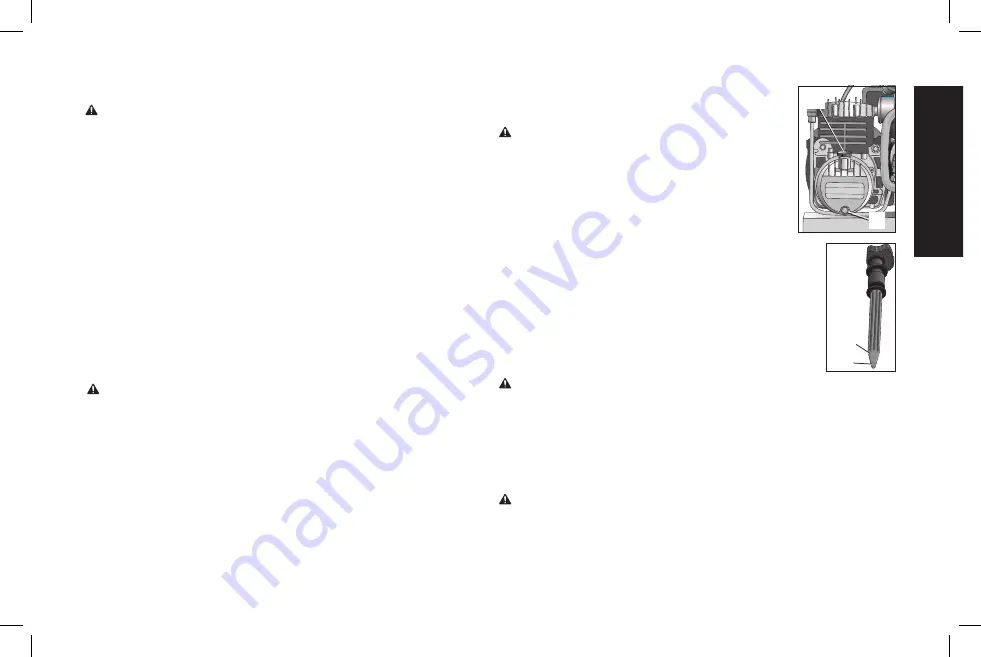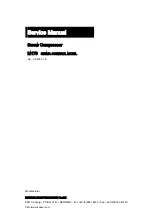
17
English
Draining Air Tank (Fig. 1)
WARNING:
Risk of unsafe operation. Risk from noise. Air
tanks contain high pressure air. Keep face and other body parts
away from outlet of drain. Use safety glasses
[ANSI Z87.1 (CAN/
CSA Z94.3)]
when draining as debris can be kicked up into face.
Use ear protection
[ANSI S12.6 (S3.19)]
as air flow noise is loud
when draining.
NOTE: All compressed air systems generate condensate that
accumulates in any drain point (e.g. tanks, filter, aftercoolers,
dryers). This condensate contains lubricating oil and/or substances
which may be regulated and must be disposed of in accordance with
local, state, and federal laws and regulations.
1. Ensure On/Off switch is in the OFF position.
2. Move compressor into an inclined position so drain valve (H) is
at the lowest point (this will assist in removing moisture, dirt, etc.
from air tanks)
3. Place a suitable container under the drain valve to catch discharge.
4. Grasp knurled knob on drain valve.
5. Slowly rotate knob to gradually bleed air from air tank.
WARNING:
Risk of bursting.
Drain air tank daily. Water will con-
dense in air tank. If not drained, water will corrode and weaken the
air tank causing a risk of air tank rupture.
CAUTION:
Risk of property damage. Drain water from air tank may
contain oil and rust, which can cause stains.
6. When air tank pressure gauge reads 10 PSI (68,9 kPa), rotate
valve to the fully open position.
7. Close drain valve when finished.
Compressor Pump Oil (Fig. 1)
CHECKING OIL
WARNING:
Hot surfaces. Risk of burn. Aftercooler,
pump head, and surrounding parts are very hot,
do not touch (see the Hot Surfaces identified in
Fig. 2). Allow compressor to cool prior to servicing.
1. Ensure On/Off switch is in the OFF position.
2. Place unit on a flat level surface.
3. Remove dipstick (K) and wipe clean.
4. Reinsert dipstick fully into oil fill port for a few
seconds to allow oil to collect on the dipstick.
5. Remove oil dipstick to read oil level. Oil should not
exceed top raised line on dipstick. If oil is below
lower mark, add same type of oil in crankcase and
follow Steps 4 - 6.
NOTE:
When filling the crankcase, the oil flows
very slowly into the pump. If the oil is added too
quickly, it will overflow and appear to be full.
CAUTION:
Risk of unsafe operation. Overfilling with
oil will cause premature compressor failure. Do not overfill.
6. Replace dipstick.
CHANGING OIL
NOTE: Pump oil contains substances that are regulated and must
be disposed of in accordance with local, state and federal laws
and regulations.
WARNING:
Hot surfaces. Risk of burn. Aftercooler, pump head, and
surrounding parts are very hot, do not touch (see the Hot Surfaces
identified in Fig. 2). Allow compressor to cool prior to servicing.
MAX
MIN
L
K
Summary of Contents for D55153-CA
Page 71: ......
















































